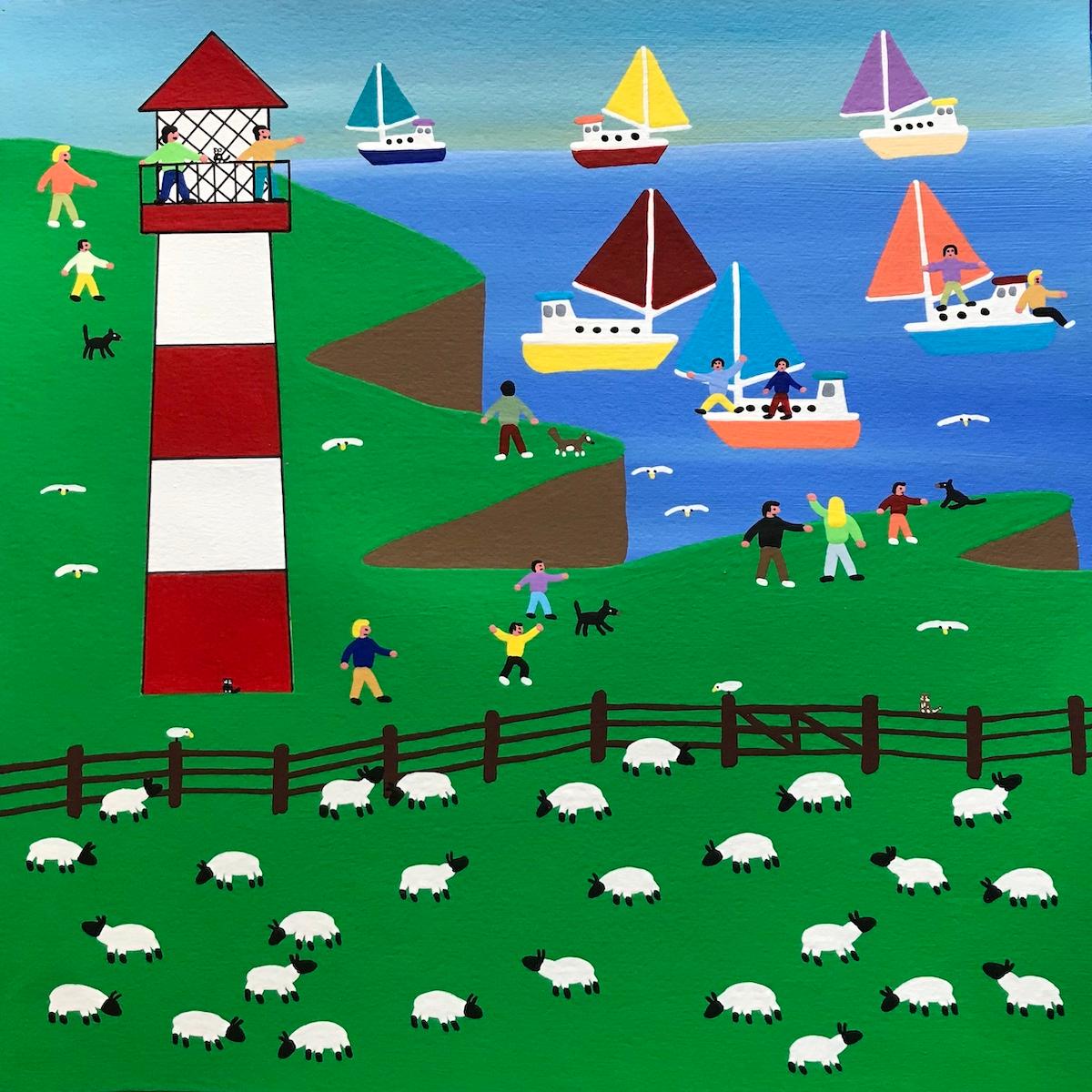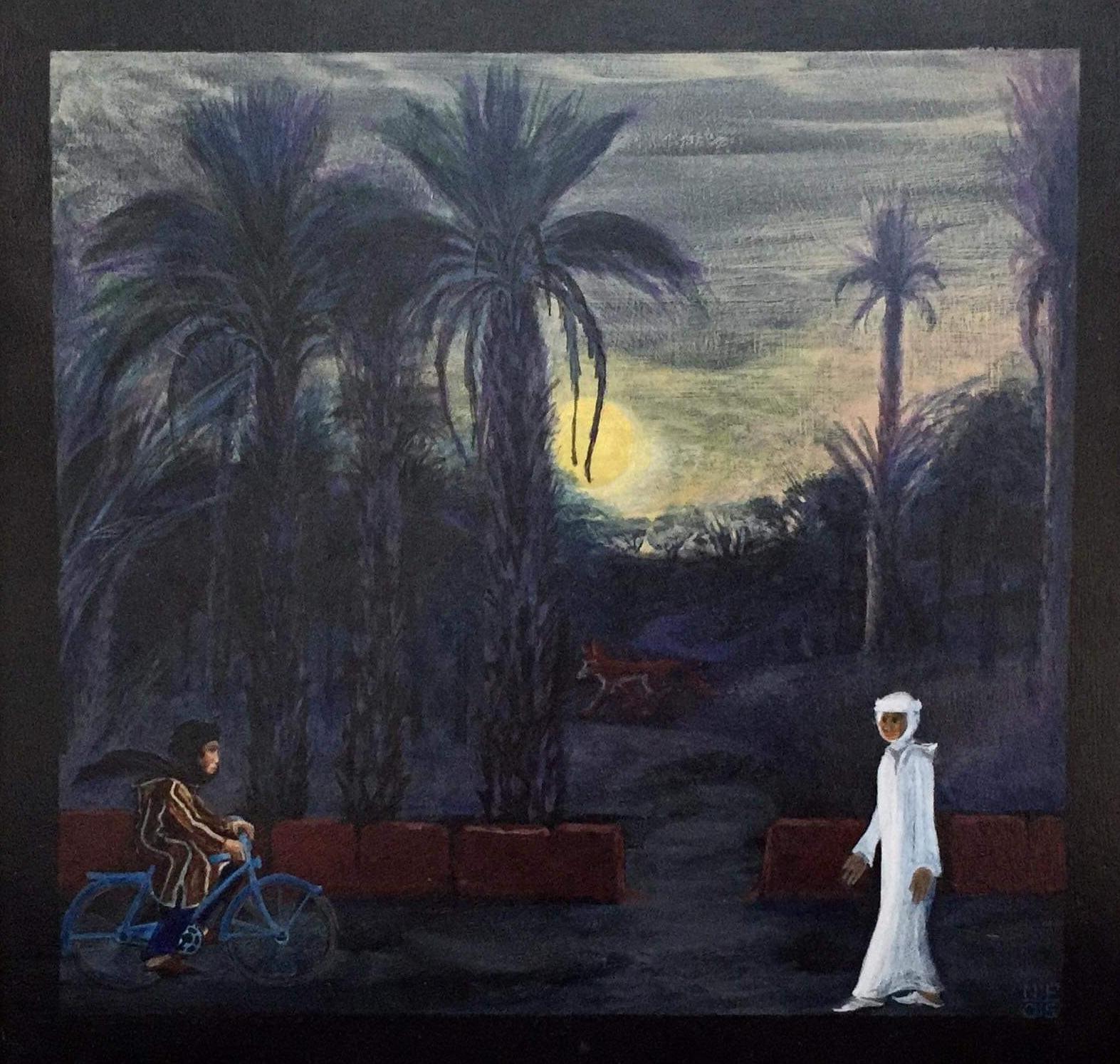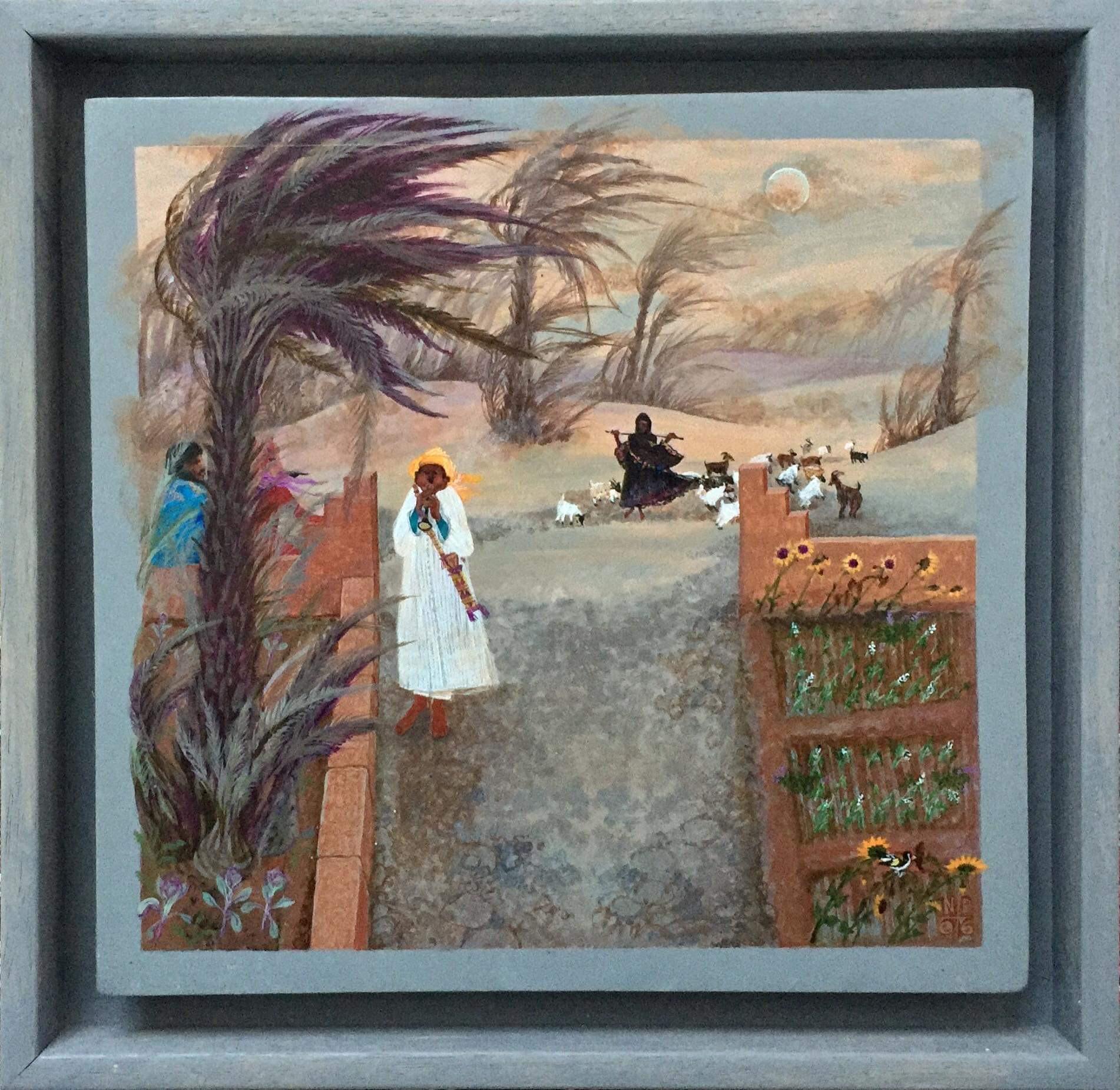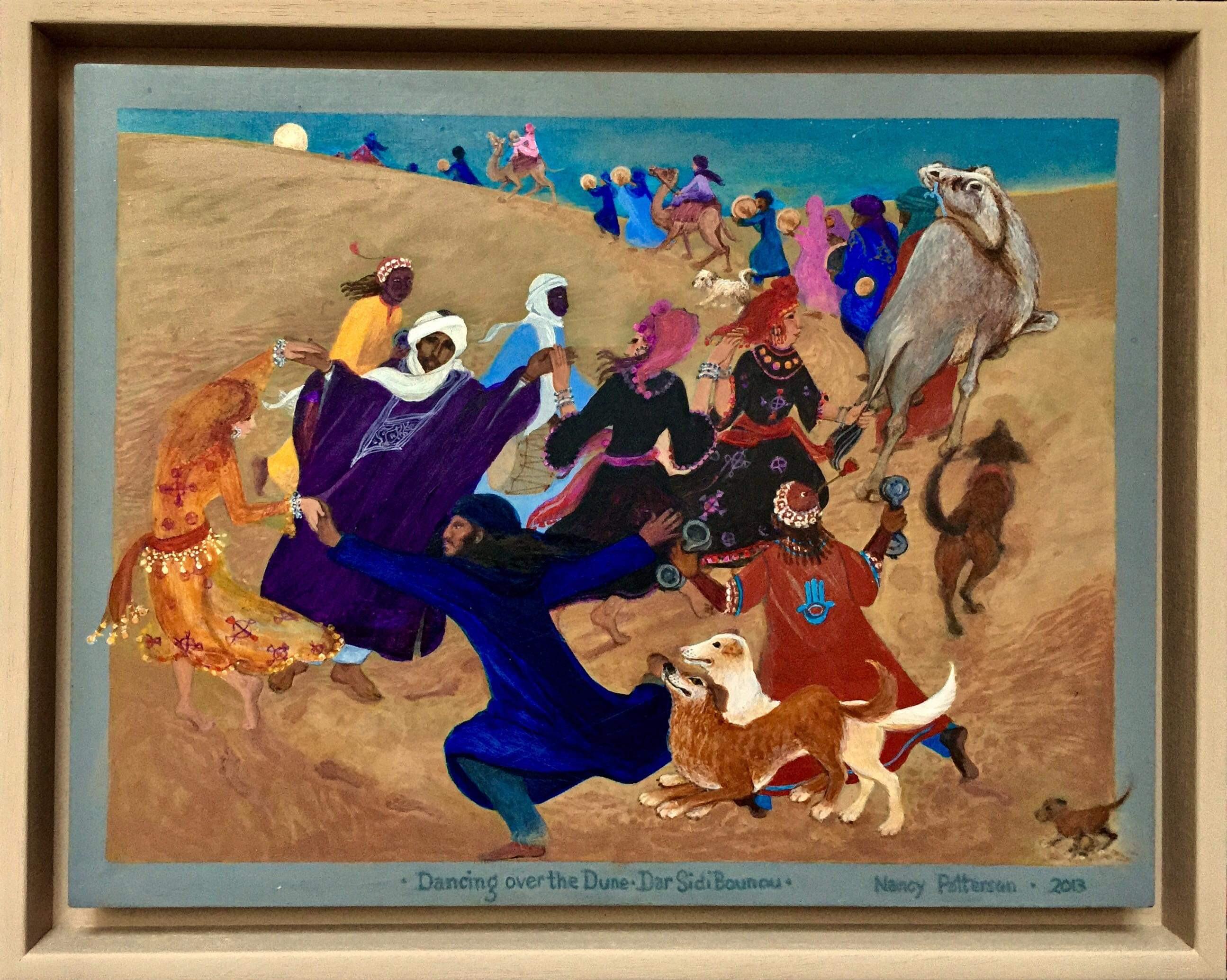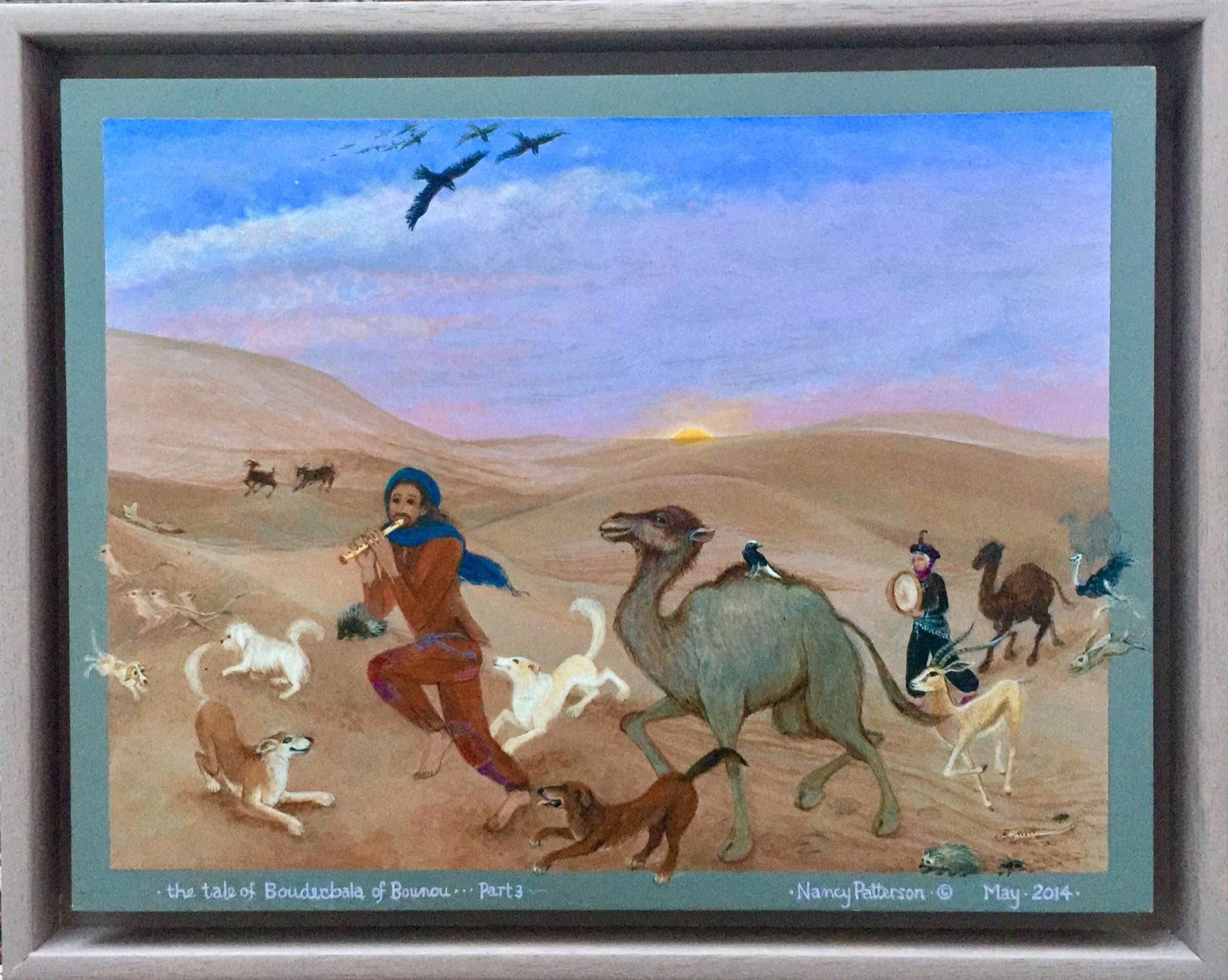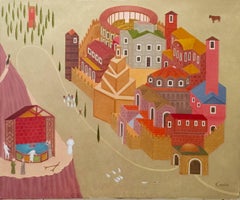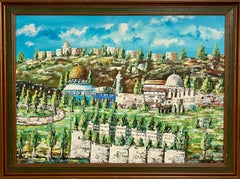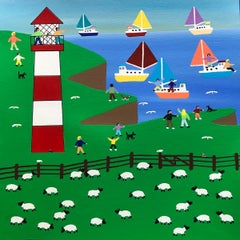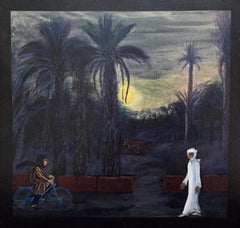Items Similar to Large Israeli Naive Art Screen Enamel Oil Painting Jerusalem Old City Folk Art
Want more images or videos?
Request additional images or videos from the seller
1 of 16
Gabriel CohenLarge Israeli Naive Art Screen Enamel Oil Painting Jerusalem Old City Folk Art
About the Item
JERUSALEM, Vielle du David, (City of David) Superlac (enamel) painting on paper, hand signed, titled and dated.
Provenance: Michael Hittleman Gallery Los Angeles.
Gabriel Cohen, (French-Israeli) Self taught, Naive painter was born in Paris in 1933, to parents from Jerusalem with a father who studied the kabbalah. Throughout World War II, the family hid from the Nazis in Paris. Images of Nazi soldiers appear in several of his paintings. In 1949, when Gabriel was 16, the family returned to Israel. They managed to save enough money to move back to the quarter where both parents were born: Ohel Moshe in Nachlaot. Gabriel served in the artillery corps and after the army, went back to live in his parents' house and earned a living polishing diamonds. The head of the polishing plant, who noticed his employee's artistic skill, allowed him to paint during work hours. He once asked Cohen if he could draw a tiger. Cohen drew him a tiger. And he did a lot of sculpting and painting on glass. He also loved to play the guitar, especially flamenco style.
Critics say he is one of Israel's greatest naive-style painters. Along with Shalom of Safed, Kopel Gurwin and Natan Heber, He is renowned as one of Israel's greatest living naive-style folk art painters, recipient of the Jerusalem Prize for Art (1987), a permanent entry in encyclopedias of naive painting, who exhibited his work not only in Israel, but also in Paris, Venezuela, Denmark and Germany; the same Gabriel Cohen whose colorful , bold Naif paintings were exhibited at the Jewish Museum in New York in 1987 alongside works by Marc Chagall; the same Gabriel Cohen about whom curator and art scholar Gideon Ofrat says, "There is no questioning his greatness."
He has shown in Paris on the Rue de Rosiers in the Marais. His impressions of his journeys, mostly imaginary, yet some real, are expressed in Cohen's paintings. Huge, colorful canvases rich in precise detail and fantasy, in which he paints the Eiffel Tower and the Russian steppes or the vistas of Paris and the Tower of Babel
"In my opinion, it's also because the Tower of Babel has some kind of phallic, erotic meaning, but also because of the internationalism, of the mixture and confusion of nations, which is an essential element in Gabi Cohen's work," says Gideon Ofrat.
There is no superlative that has not been lavished on Cohen's work by art critics, since he began showing his paintings at age 40, All the art critics seemed to agree at once that Cohen is one of the greatest naive-style painters in Israel. Their counterparts abroad seconded this view.
About a year and a half ago, Zadka organized a show for Cohen at the Jerusalem Artists' House. The Tel Aviv Museum bought a painting of Gabi's and so did the Israel Museum, and several artists bought his drawings. He is a great, great painter. There is no painter who is more of a symbolist and illustrative artist than he is. As a painter myself, I admire him." The Yom Kippur War in 1973 sparked an artistic breakthrough for Cohen; it was at that time that he began to sit on the sidewalk after his work as a diamond polisher and paint. Not long afterward, in early 1974, he did a painting he called "Moses on the Mountain." Ruth Debel, of the Debel Gallery in Ein Kerem, passed by and saw it on the street. She asked how much he wanted for it, and for the first time in his life, he realized that his work had financial value.
His first show was at the Debel Gallery in 1974. The response was overwhelming. Cohen was immediately declared a genius. His paintings at the gallery were purchased and he continued to create new paintings. That same year, he was invited to take part in a group exhibition of naive artists at the Kunsthaus in Zurich, and a year later, his work was included in a traveling show of naive-style artists from Israel that was exhibited in Denmark and Germany. Soon after that he was invited to be part of group shows in Venezuela and at the Tel Aviv Museum.
Cohen had four solo shows at the Debel Gallery.
Awards And Prizes
1987 Jerusalem Prize for Painting and Sculpture
1999 Shoshana Ish-Shalom Prize for special contribution to art, Jerusalem
He has exhibited alongside all of the Israeli great artists. included in the Naive Art Group exhibition Gvanim Art Gallery, Jerusalem Rubin, Rachel Roman, Yitzhak Zarembo, Leah Moscovitz, Shalom (of Safed) Steinberg, Michael Denisov, Salva Harbon, Haim Cohen, Gabriel Chanannia, Joseph (Jojo)
Local Hero: Portrait of the Arab in Israeli Painting The Gutman Museum - The Writers House, Tel Aviv
Blum, Ludwig Pann, Abel Sima, Miron Janco, Marcel Allweil, Arieh Arieli, Mordechai Schloss, Ruth Geva, Tsibi Glotman, Yehoshua (Shuka) Cohen, Gabriel Kna'an, Ahmed Gutman, Nachum Rubin, Reuven Reeb, David
- Creator:Gabriel Cohen (1933 - 2017, French, Israeli)
- Dimensions:Height: 22.5 in (57.15 cm)Width: 35 in (88.9 cm)
- Medium:
- Movement & Style:
- Period:
- Condition:good. minor wear. studio condition. please see photos.
- Gallery Location:Surfside, FL
- Reference Number:1stDibs: LU3827257882
About the Seller
4.9
Platinum Seller
These expertly vetted sellers are 1stDibs' most experienced sellers and are rated highest by our customers.
Established in 1995
1stDibs seller since 2014
1,591 sales on 1stDibs
Typical response time: 1 hour
- ShippingRetrieving quote...Ships From: Surfside, FL
- Return PolicyA return for this item may be initiated within 3 days of delivery.
Authenticity Guarantee
In the unlikely event there’s an issue with an item’s authenticity, contact us within 1 year for a full refund. DetailsMoney-Back Guarantee
If your item is not as described, is damaged in transit, or does not arrive, contact us within 7 days for a full refund. Details24-Hour Cancellation
You have a 24-hour grace period in which to reconsider your purchase, with no questions asked.Vetted Professional Sellers
Our world-class sellers must adhere to strict standards for service and quality, maintaining the integrity of our listings.Price-Match Guarantee
If you find that a seller listed the same item for a lower price elsewhere, we’ll match it.Trusted Global Delivery
Our best-in-class carrier network provides specialized shipping options worldwide, including custom delivery.More From This Seller
View AllMagic Realist Surrealist Latin American Naive Fantasy Painting
By German Ramon Duron Lanza
Located in Surfside, FL
Magic realist fantasy painting in the manner of Ernst Fuchs and Arik Brauer.
Naïve art is any form of visual art that is created by a person who lacks the formal education and training that a professional artist undergoes (in anatomy, art history, technique, perspective, ways of seeing). Unlike folk art, naïve art does not necessarily evince a distinct cultural context or tradition. Naïve art is recognized, and often imitated, for its childlike simplicity and frankness. Paintings of this kind typically have a flat rendering style with a rudimentary expression of perspective.
One particularly influential painter of "naïve art" was Henri Rousseau (1844–1910), a French Post-Impressionist who was discovered by Pablo Picasso.
Naïve art is often seen as outsider art that is by someone without formal (or little) training or degree. While this was true before the twentieth century, there are now academies for naïve art. Naïve art is now a fully recognized art genre, represented in art galleries worldwide.
Museums devoted to naïve art now exist in Kecskemét, Hungary; Riga, Latvia; Jaen, Spain; Rio de Janeiro, Brasil; Vicq France and Paris. "Primitive art" is another term often applied to art by those without formal training, but is historically more often applied to work from certain cultures that have been judged socially or technologically "primitive" by Western academia, such as Native American, sub saharan African or Pacific Island art (see Tribal art). This is distinguished from the self-conscious, "primitive" inspired movement primitivism. Another term related to (but not completely synonymous with) naïve art is folk art.
There also exist the terms "naïvism" and "primitivism" which are usually applied to professional painters working in the style of naïve art (like Paul Gauguin, Mikhail Larionov, Paul Klee).
At all events, naive art can be regarded as having occupied an "official" position in the annals of twentieth-century art since - at the very latest - the publication of the Der Blaue Reiter, an almanac in 1912. Wassily Kandinsky and Franz Marc, who brought out the almanac, presented 6 reproductions of paintings by le Douanier' Rousseau (Henri Rousseau), comparing them with other pictorial examples. However, most experts agree that the year that naive art was "discovered" was 1885, when the painter Paul Signac became aware of the talents of Henri Rousseau and set about organizing exhibitions of his work in a number of prestigious galleries.
The Earth Group (Grupa Zemlja) were Croatian artists, architects and intellectuals active in Zagreb from 1929 to 1935. The group included the painters Krsto Hegedušić, Edo Kovačević, Omer Mujadžić, Kamilo Ružička, Ivan Tabaković, and Oton Postružnik, the sculptors Antun Augustinčić, Frano Kršinić, and the architect Drago Ibler.
A term applied to Yugoslav (Croatian) naive painters working in or around the village of Hlebine, near the Hungarian border, from about 1930. Some of the best known naive artists are Dragan Gaži, Ivan Generalić, Josip Generalić, Krsto Hegedušić, Mijo Kovačić, Ivan Lacković-Croata, Franjo Mraz, Ivan Večenaj and Mirko Virius.
Camille Bombois (1883–1970) Ferdinand Cheval, known as 'le facteur Cheval' (1836–1924)
Henry Darger (1892–1973) L. S. Lowry (1887–1976) Grandma Moses, Anna Mary Robertson (1860–1961) Nikifor (1895–1968) Poland, Horace Pippin (1888–1946) Jon Serl (1894-1993) United States
Alfred Wallis (1855–1942) Scottie Wilson (1890–1972) Gesner Abelard (b. 1922) Jan Balet (1913–2009) Michel Delacroix (b. 1933) France Howard Finster (1916–2001) Ivan Rabuzin (1921–2008)
Spontaneous Art Museum in Brussels
Art en Marge Museum in Brussels
MADmusée in Liege
International Museum of Naive Art of Brazil in Cosme Velho, Rio de Janeiro
Gallery Jacques Ardies in São Paulo
Musée international d'art naïf de Magog in Magog
Croatian Museum of Naïve Art in Zagreb
Gallery of Croatian Naïve Art...
Category
20th Century Folk Art Figurative Paintings
Materials
Canvas, Acrylic
Fantastic Village Scene Modern Irish Magic Realism Oil Painting
By Philip Castle
Located in Surfside, FL
Philip Castle was an Irish Painter and husband to artist Barry Castle
He is rarely exhibited. His detailed, meticulous work took a long time to complete...
Category
20th Century Folk Art Landscape Paintings
Materials
Canvas, Oil
Rare Israeli Naive Art Oil Painting Jerusalem Israel Old City Landscape Folk Art
Located in Surfside, FL
JERUSALEM, Vielle du David, (City of David)
Oil painting on canvas
Hand signed in Hebrew (Perlman, Pearlman or Perelman. There are numerous artists with this name. we are unsure which this is)
Provenance: private Judaica collection
Done in the folk art style, Outsider art style of Gabriel Cohen who along with Shalom of Safed, Kopel Gurwin and Natan Heber, is renowned as one of Israel's greatest living naive-style folk art painters. Israeli naive painting has been exhibited not only in Israel, but also in Paris, Venezuela, Denmark and Germany.
Gabriel Cohen obviously influenced this artist. He won the 1987 Jerusalem Prize for Painting and Sculpture. 1999 Shoshana Ish-Shalom Prize for special contribution to art, Jerusalem. He has exhibited alongside all of the Israeli great artists. included in the Naive Art Group exhibition Gvanim Art Gallery, Jerusalem Rubin, Rachel Roman, Yitzhak Zarembo, Leah Moscovitz, Shalom (of Safed) Steinberg, Michael Denisov, Salva Harbon, Haim Cohen, Gabriel Chanannia, Joseph (Jojo)
Local Hero: Portrait of the Arab in Israeli Painting The Gutman Museum - The Writers House, Tel Aviv
Blum, Ludwig Pann...
Category
20th Century Folk Art Landscape Paintings
Materials
Oil, Canvas
Naive London Street Scene Folk Art Oil Painting Big Ben, Parliament, Union Jack
By Andrew Murray
Located in Surfside, FL
Big Ben, House of Parliament with Union Jack flag, Thames River, boats, barges, airplane and double decker red bus. Classic London street scene.
24 inches by 11 inches in a frame 24.5 inches by 11.5 inches.
ANDREW MURRAY became known and loved as an imaginative Naive painter who captured the character of cities (especially Cape Town and London) with humorous and affectionate insight. An English counterpart to Michel Delacroix of Paris and Charles Fazzino of New York
He was born in north China, the son of a missionary. As a child of five he had his first lesson in painting from the son of another, the 10-year- old Mervyn Peake...
Category
20th Century Folk Art Figurative Paintings
Materials
Oil, Canvas
French Folk Art Naive Oil Painting Workers in Vineyard, Les Vignes aux Gitans
Located in Surfside, FL
Max Savy Oil on canvas painting depicting a village scene with winemakers in a vineyard by artist Max Savy (French, b. 1918). Signed in the lower right. Frame measures 24.5 inches x 28 inches. canvas is 18 X 22 inches.,
Perfect for a wine cellar or cave.
Max Savy (French, 1918-2010) painted scenes of everyday life in the French Corbieres region, which garnered much success during his life. Though the artist remained silent about his early life, it's known his father instilled in him a belief in the humanist socialism philosophy of French Socialist Party leader, Jean Jaures. In 1938, at age 20, he moved to Carcassonne to attend school. There, he married and settled into a teaching position, joining the French Resistance during World War II and earning the Cross of the Combatant. After the war, he created the work for which he is most admired. Max Savy paintings are part of France's heritage collection, and the artist became a knight of the National Order of Merit in 1973. Max Savy's paintings and artworks include scenes of peasants in the fields. Max Savy was active/lived in France. Max Savy is known for folk art style painting of village architecture, vintners, figures in landscape, wine makers, marine scenes. His work is similar in style to the naive, folk art paintings of Michel Delacroix and Fanch Ledan. This is quite similar to a work I had titled "Les Vignes Aux Gitans" (the gypsy grape vines)
So i assume this is also a vineyard painting...
Category
Mid-20th Century Folk Art Landscape Paintings
Materials
Canvas, Oil
1980s Vintage American Street Scene Painting, Landscape with Taxi Cabs
By Val Lewton
Located in Surfside, FL
Val Edwin Lewton (May 23, 1937 – April 24, 2015) was a painter and museum exhibition designer. As an artist, he created Realist acrylic paintings and watercolors of urban and suburban scenes, predominantly in the Washington, D.C., area, where he lived and exhibited.
Val Lewton was born May 23, 1937, in Santa Monica, California. His father, also named Val Lewton, produced a string of successful and influential B movies for RKO Pictures, including Cat People (1942) and I Walked with a Zombie (1943). His mother, Ruth Knapp, was a painter and teacher of autistic children.
He graduated in 1959 from Whitman College in Walla Walla, Washington, and earned a master's degree in fine arts from Claremont University in 1962. After moving to Washington, D.C., he served on the staff of the Smithsonian American Art Museum for 32 years, simultaneously maintaining a career as a painter in his own right.
Lewton died in 2015s oon afterwards, exhibitions of his paintings were planned for the Katzen Arts Center (June 17 – August 13, 2017) and Addison/Ripley Fine Art (June 3 – July 8, 2017).
Chiefly known for his landscapes, Lewton generally depicted cities and suburbs with a detached, impersonal sensibility. Writing about his watercolors in Arts magazine in 1980, Harry Rand observed, “Either by implication or statement, personalities are absent from Lewton’s work; there is hardly a sense of the lives that move through those spaces he describes.” The critic compared the artist to Fairfield Porter, Edward Hopper, and Charles Sheeler.
Lewton painted from a young age. On a family trip to the Museum of Modern Art in New York City, he discovered the work of Henri Matisse, an encounter that permanently influenced his artistic vision. In the early 1960s, Lewton lived in southern California and taught art classes at the University of California Riverside. During this period, he was inspired by the paintings of Roger Kuntz...
Category
1980s Photorealist Landscape Paintings
Materials
Acrylic, Archival Paper
You May Also Like
Cliff Top Walk, Gordon Barker, Lighthouse painting, Coastal art, Folk art, 2022
Located in Deddington, GB
Cliff top walk by Gordon Barker [2019]
original and hand signed by the artist
Acrylic on paper
Image size: H:29 cm x W:29 cm
Complete Size of Unframed W...
Category
21st Century and Contemporary Folk Art Landscape Paintings
Materials
Paper, Acrylic
Folk Art Painting, British Canadian artist, Morocco Kasbah Fields Water Egrets
By Nancy Patterson
Located in Norfolk, GB
This attractive Folk Art painting on board is by the fabulous British Canadian artist Nancy Patterson. It comes from her series ‘Days in the...
Category
Early 2000s Folk Art Figurative Paintings
Materials
Acrylic, Board
Folk Art Painting, Female Canadian artist, Morocco Desert Fox, Moonlight Palms
By Nancy Patterson
Located in Norfolk, GB
This atmospheric Folk Art painting on board is by the fabulous British Canadian artist Nancy Patterson. It comes from her series ‘Days in the Desert Sun, Nights Under the Magical Moon’ , a compelling set of paintings in the Folk idiom, made by Nancy about her life on the edge of the Desert in Southern Morocco. The paintings tell the narratives, the tales of the community that over the past eighteen years has become her home.
Artwork details:
Nancy Patterson, 'The Desert Fox', acrylics on mahogany plywood, unframed 24cm x 25cm, 2005.
Initialed on the front.
Provenance, directly from the artist studio.
Condition: in excellent condition.
There is something very comforting about the term Folk Art, derived from the idea that a work of art is firmly rooted in the community it depicts. Folk Art can initiate feelings of splendid joy. It is often misjudged as holding less regard that some of its fine-art cousins but we need look no further than the fabulous British artist Alfred Wallis or the captivating Canadian painter Maud Lewis to understand that Folk Art can be just as complex in its formal arrangements, compositions and choice of colour palette. Another myth, possibly by those who could not explain the beauty in the Folk Art form, is that this type of art is the sole premise of artists who have had no formal training.
There is something intriguing about paintings by the moonlight. Nancy uses the effect to emphasis the three main characters, herself, Daoud and the fox!
Nancy narrates the painting,
'Daoud on his way to meet a local Elder, known as the Desert Fox, while a four legged Fox lurks about the background. Most men in the desert area around Mhamid wear traditional garments- a Gandoura (on Daoud) or a Djellaba (on the Fox) which look elegant when the wearer is just standing around or sitting on a camel, but a little strange on a bicycle or motorbike with a Shesh (turban) flowing in the breeze. A Shesh makes any man look good, and provides protection from sun and wind; almost all Moroccan men wear a Shesh most of the time, except when donning an unsuitable for the climate, western suit...
Category
Early 2000s Folk Art Figurative Paintings
Materials
Acrylic, Board
Folk Art Painting Female Artist Morocco Desert Palm Sunflowers Goats Moonlight
By Nancy Patterson
Located in Norfolk, GB
This vibrant Folk Art painting on on board is by the fabulous British Canadian artist Nancy Patterson. It comes from her series ‘Days in the Desert Sun...
Category
Early 2000s Folk Art Landscape Paintings
Materials
Board, Acrylic
Folk Art Painting Africa Morocco Desert Dance Dogs Camels Animals Dunes Moon
By Nancy Patterson
Located in Norfolk, GB
This vibrant Folk Art painting on board is by the wonderful British Canadian artist Nancy Patterson. It comes from her series ‘Days in the Desert Sun, ...
Category
2010s Folk Art Figurative Paintings
Materials
Acrylic, Board
Folk Art Painting Africa Dance Music Animal Morocco Desert Gnawa Music Dog Camel
By Nancy Patterson
Located in Norfolk, GB
This captivating Folk Art painting on on board is by the fabulous British Canadian artist Nancy Patterson. It comes from her series ‘Days in the Desert Sun, Nights Under the Magical Moon’ , a compelling set of paintings in the Folk idiom made by Nancy about her life on the edge of the Desert in Southern Morocco. The paintings tell the narratives, the tales of the community that over the past eighteen years has become her home.
Artwork details:
Nancy Patterson, 'The tale of Bouderbala of Bounou, Part 3', acrylic on board, with frame 29.5cm x 38cm, 2014.
Signed on the front. Professionally framed in a painted wooden shadow boxed. Ready to hang.
Provenance, directly from the artist studio.
Condition: in excellent condition.
There is something very comforting about the term Folk Art, derived from the idea that a work of art is firmly rooted in the community it depicts. Folk Art can initiate feelings of splendid joy. It is often misjudged as holding less regard that some of its fine-art cousins but we need look no further than the fabulous British artist Alfred Wallis or the captivating Canadian painter Maud Lewis to understand that Folk Art can be just as complex in its formal arrangements, compositions and choice of colour palette. Another myth, possibly by those who could not explain the beauty in the Folk Art form, is that this type of art is the sole premise of artists who have had no formal training.
This painting is an excellent example of a lyrical tale. It is as if with our gaze we traverse the painting, joining in the energy and movement of those in the painting. Nancy explains the tale,
'Bouderbala is the Happy Wanderer, a Pied Piper in Rags and Patches who travels carefree, alone or with his companions. He is one of the seven main Spirits in a Gnawa Leila Ceremony; he dances in a clownish loose-limbed way, but sometimes adds surprising acrobatic moves. Daoud is always cheerful like Bouderbala, as well as rather unpredictable. In his younger days his family wanted him to study Law, but he opted for Gymnastics. One day when we were out in the dunes and came across three Nomad kids playing Spin the Hoop with an old bicycle...
Category
2010s Folk Art Figurative Paintings
Materials
Board, Acrylic
